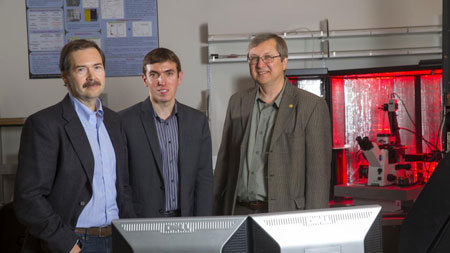| Posted: Nov 24, 2014 |
Researchers study graphene and ammonia to improve digital memory technology
|
|
(Nanowerk News) The improvements in random access memory that have driven many advances of the digital age owe much to the innovative application of physics and chemistry at the atomic scale.
|
|
Accordingly, a team led by University of Nebraska–Lincoln (UNL) researchers has employed a Nobel Prize-winning material and common household chemical to enhance the properties of a component primed for the next generation of high-speed, high-capacity RAM.
|
|
The team, which published its findings in the Nov. 24 edition of the journal Nature Communications ("Ferroelectric tunnel junctions with graphene electrodes"), engineered and tested improvements in the performance of a memory structure known as a ferroelectric tunnel junction.
|
 |
| Left to right, University of Nebraska-Lincoln scientists Alexei Gruverman, Alexander Sinitskii and Evgeny Tsymbal.
|
|
The junction features a ferroelectric layer 100,000 times thinner than a sheet of paper, so thin that electrons can "tunnel" through it. This layer resides between two electrodes that can reverse the direction of its polarization — the alignment of positive and negative charges used to represent "0" and "1" in binary computing — by applying electric voltage to it.
|
|
The researchers became the first to design a ferroelectric junction with electrodes made of graphene, a carbon material only one atom thick. While its extreme conductivity makes graphene especially suited for small-scale electronics, the authors' primary interest lay in how it accommodated nearly any type of molecule — specifically, ammonia — they placed between it and the ferroelectric layer.
|
|
A junction's polarity determines its resistance to tunneling current, with one direction allowing current to flow and the other strongly reducing it. The researchers found that their graphene-ammonia combination increased the disparity between these "on" and "off" conditions, a prized outcome that improves the reliability of RAM devices and allows them to read data without having to rewrite it.
|
|
"This is one of the most important differences between previous technology that has already been commercialized and this emergent ferroelectric technology," said Alexei Gruverman, a Charles Bessey Professor of physics who co-authored the study.
|
|
Ferroelectric materials naturally boast the quality of "non-volatility," meaning they maintain their polarization — and can hence retain stored information — even in the absence of an external power source. However, the infinitesimal space between the positive and negative charges in a tunnel junction makes maintaining this polarization especially difficult, Gruverman said.
|
|
"In all memory devices, there is a gradual relaxation, or decrease, of this polarization," he said. "The thinner the ferroelectric layer is, the more difficult it is to keep these polarization charges separate, as there is a stronger driving force in the material that tries to get rid of it."
|
|
Gruverman said the team's graphene-ammonia combination also shows promise for addressing this prevalent issue, significantly improving the stability of the junction's polarization during the study.
|

